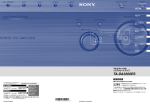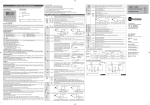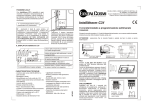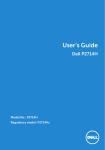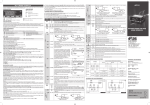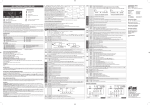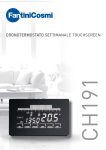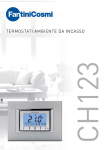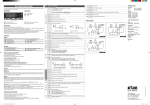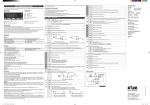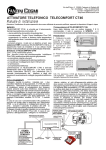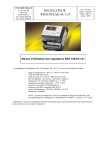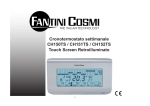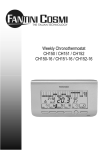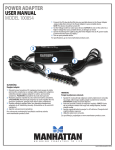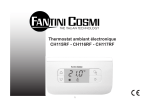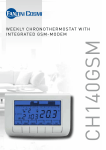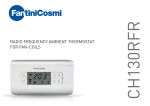Download L02B_istruzioni - Fantini & Cosmi
Transcript
L02B--/L22E-- INSTRUCTIONS FOR USE Thank you for having chosen a Fantini Cosmi product. Before installing the instrument, please read these instructions carefully to ensure maximum performance and safety. DESCRIPTION INDICATIONS Press to display the value and then use reference instrument. Exit from calibration by pressing button X . + or to make the read value coincide with the value measured by the CONFIGURATION PARAMETERS Setup menu is accessed by pressing buttons + X for 5 seconds. With button or select the parameter to be modified. Press button to display the value. By keeping button pressed, use button or to set the desired value. When button is released, the newly programmed value is stored and the following parameter is displayed. To exit from the setup, press button X or wait for 30 seconds. Thermostat output PAR RANGE SCL 1°C; 2°C; °F BAU NON / SBY SIM 0...100 OS1 -12.5..12.5°C ADR 1...255 AC1-5 LTR-5 With BAU =SBY, the stand-by button is enabled. Display slowdown. Probe T1 offset. Via Dell’Osio 6 20090 Caleppio di Settala MI ITALIA Phone no. +39 02 95682.222 Fax no. +39 02 95307006 address for PC communication. (function not available) Web: www.fantinicosmi.it e-mail: [email protected] WIRING DIAGRAMS DESCRIPTION V S e t p o i n t b u t to n . Increase button. D e c r e a s e b u t to n . Exit / Stand-by button. INSTALLATION Insert the controller through a hole measuring 71x29 mm. Make sure that electrical connections comply with the paragraph “wiring diagrams”. To reduce the effects of electromagnetic disturbance, keep the sensor and signal cables well separate from the power wires. Fix the controller to the panel by means of the suitable clips, by pressingly gently; if fi tted, check that the rubber gasket adheres to the panel perfectly, in order to prevent debris and moisture infi ltration to the back of the instrument. Place the probe T1 inside the room in a point that truly represents the temperature of the stored product. OPERATION DISPLAY During normal operation, the display shows either the temperature measured or one of the following indications: OFF OR TUN / 5.4 Controller in stand-by Probe T1 overrange or failure Controller in autotuning E1 E2 E3 In tuning: timeout1 error In tuning: timeout2 error In tuning: overrange error SETPOINT (display and modifi cation of desired temperature value) press button for at least half second, to display the setpoint value. By keeping button pressed, use button or to set the desired value (adjustment is within the minimum SPL and the maximum SPH limit). When button is released, the new value is stored. STAND-BY Button , when pressed for 3 seconds, allows the controller to be put on a standby or output control to be resumed (with SB =YES only). Control improvement To reduce overshoot, reduce the integral action reset 1AR . To increase the response speed of the system, reduce the proportional band 1PB . Caution: doing this makes the system less stable. To reduce swings in steady-state temperature, increase the integral action time 1IT ; system stability is thus increased, although its response speed is decreased. To increase the speed of response to the variations in temperature, increase the derivative action time 1DT . Caution: a high value makes the system sensitive to small variations and it may be a source of instability. RECALIBRATION Have a precision reference thermometer or a calibrator to hand. Ensure that OS1 =0 and SIM =0. Switch the controller off then on again. During the auto-test phase, press buttons X + , and keep them pressed till the controller shows 0AD . With buttons and select 0AD or SAD : 0AD allows a calibration of 0, inserting a constant correction over the whole scale of measurement. SAD allows a calibration of the top part of the measurement scale with a proportional correction between the calibration point and 0. -40 … 105°C for L02B-0. 0 … 100 % r. H. for L22E-- °F : measuring range -40 … 221°F for L02B-- 10 9 10 11 V+ VIN V- 2 3 4 6 2 7 11 OUT1 16(4)A OUT1 16(4)A -50..SPH Minimum limit for 1SP setting SPH SPL.150° Maximum limit for 1SP setting 1SP SPL... SPH 1Y HY / PID 1HY 230V~ (L22EM1A) / 12Vac/dc (L22EI1A) 3 4 6 7 ON 1SP 1SP+1HY T[°] Fig. 1a. ON/OFF refrigerating control (1Y=HY, 1HY>0) -19.9…19.9°C Proportional band [PID control]. -19.9..19.9%r.H Set 1PB on a value greater than zero to make the output work in refrigerating mode, vice versa set on a value lower than zero to make the output work in heating mode. With 1PB=0 the output is always off. With a proportional controller, the temperature is controlled by varying the time of activation of the output. The nearer the temperature to set point, the less time of activation. A small proportional band increases the promptness of response of the system to temperature variations, but tends to make it less stable. A purely proportional control stabilises the temperature within the proportional band but does not cancel the deviation from the set point. 0…999s OFF 1SP-1HY T[°] 1SP Fig. 1b. ON/OFF heating control (1Y=HY, 1HY<0) Overshoot Steady-state error TECHNICAL DATA 1SP 1PB Process temperature L22E--: 0-1V (LS160A) L02B--: NTC 10K (LS130) Temperature Measuring Range 1PBx1AR% Process temperature integral control action area 1PB L22E--: L02B--: 0…100% U.R. -40…105°C Measuring accuracy L22E…: L02B…: <±0.7%r.H. in the measuring range <±0.3°C -40…100°C; ±1°C out of that range Operating conditions Derivative action time [PID control]. Response overshoot in a system controlled by a Proportional1SP Derivative controller may be reduced by inserting a derivative action in the control. A high derivative action (1DT high) makes the system very sensitive to small temperature variations and causes instability. With1DT=0 the derivative control is disabled. -10 … +50°C; Overshoot 15…80% r.H. CE (Reference Norms) 1PB Process temperature EN60730-1; EN60730-2-9; EN55022 (Class B); EN50082-1 Front protection Time 0…100% 12Vac/dc±10%, 3W 230Vac±10%, 50/60Hz, 3W Inputs Integral action time [PID control]. Time 1AR L02BI1A/L22EI1A L02BM1A/L22EM1A OUT1 16(4)A 240Vac Overshoot 0…999s Power supply Relay outputs Time The steady-state error is cancelled by inserting an integral action into the control system. The integral action 1SP time, determines the speed with which the steady-state temperature is achieved, but a high speed ( 1IT low) may be the cause of overshoot and instability in the response. With 1IT=0 the integral control is disabled. 1DT L02BI1A-L02BM1A -19.9…19.9°C Thermostat differential [control with hysteresis]. -19.9..19.9%r.H Set 1HY on a value greater than zero to make the output work in refrigerating mode, vice versa set on a value lower than zero to make the output work in heating mode. With 1HY=0 the output is always off. OFF 1IT L22EI1A-L22EM1A Control mode. With 1Y=HY you select control with hysteresis: parameters 1HY and 1CT are used. With 1Y=PID you select a Proportional-Integral-Derivative control mode: parameters 1PB, 1IT, 1DT, 1AR, 1CT will be used. ON 1PB 230V~ (L02BM1A) / 12Vac/dc (L02BI1A) Setpoint (value to be maintained in the room). Temperature Errors If the autotuning function failed, the display shows an error code: E1 timeout1 error: the controller could not bring the temperature within the proportional band. Increase 1SP in case of heating control, vice versa, decrease 1SP in case of refrigerating control and re-start the process. E2 timeout2 error: the autotuning has not ended within the maximum time allowed (1000 cycle times). Re-start the autotuning process and set a longer cycle time 1CT . E3 temperature overrange: check that the error was not caused by a probe malfunction, then decrease 1SP in case of heating control, vice versa increase 1SP in case of refrigerating control and then re-start the process. To eliminate the error indication and return to the normal mode, press button X . 2°C : measuring range SPL X. During autotuning with the actual temperature measured. During the entire autotuning phase, the display alternates In case of power failure, when power is resumed, after the initial autotest phase, the controller resumes the autotuning function. To abort the autotuning, without modifying the previous control parameters, keep button X pressed for 3 seconds. After the autotuning has taken place successfully, the controller updates the control parameters and start to control. rH - 40/-19. 9 … 99. 9/105° C for L02B-0. 0 … 100 % r. H. for L22E-- Caution: upon changing the SCL value, it is then absolutely necessary to re-configure the parameters relevant to the absolute and relative temperatures (SPL, SPH, 1SP, 1HY, etc..). CONTROLLER AUTOTUNING IN PID MODE Before starting Adjust the setpoint 1SP to the desired value. Set 1Y =PID. Make sure that the 1PB value matches the desired control mode (1PB <0 for heating; 1PB >0 for refrigeration). Start autotuning Keep buttons + pressed for 3 seconds. 1CT blinks on the display. With + or set the cycle time in order to define the dynamic of the process to be controlled. To start autotuning press + or wait for 30 seconds. To abort the autotuning function, press Readout scale. 1°C : measuring range Temperature Fig.1 — Front panel Reset of integral action time referred to 1PB [PID control]. Decreasing the parameter1AR reduces the integral control action zone, and consequently the overshoot (see figure on paragraph1IT). 1CT 0…255s Cycle time. In the ON/OFF control (1Y=HY), after the output has switched on or off, it will remain in the new state for a minimum time of1CT seconds, regardless of the temperature value. In the PID control (1Y=PID), the cycle time is the period of time in which the output completes a cycle (Time ON + Time OFF). The faster the system to be controlled reacts to temperature changes, the smaller the cycle time should be, in order to obtain a greater temperature stability and less sensitivity to load variations. 1PF ON / OFF Output state in case of probe failure. IP55 taratura e lo 0. Premere per visualizzare il valore e agire con + strumento di riferimento. L’uscita dalla calibrazione si ha premendo il tasto X . L02B--/L22E-- ISTRUZIONI D’USO Vi ringraziamo per la preferenza accordataci scegliendo un prodotto Fantini Cosmi. Prima di procedere all’installazione dello strumento, leggete attentamente il presente foglio d’istruzioni: solo così potrete ottenere massime prestazioni e sicurezza. INDICAZIONI Per accedere al menù di configurazione dei parametri, premere per 5 secondi i tasti + X. o selezionare il parametro da modificare Con i tasti Premere il tasto per visualizzare il valore. Mantenendo premuto agire con i tasti o per impostare il valore desiderato. Al rilascio del tasto il nuovo valore viene memorizzato e viene visualizzato il parametro successivo. Per uscire dal setup premere il tasto X o attendere 30 secondi. Fig.1 — Pannello frontale Tasto incremento. T a s to d e c r e m e n to . Tasto uscita / Stand-by. PAR RANGE SCL 1°C; 2°C; °F INSTALLAZIONE DESCRIZIONE scala di lettura. 1°C : range di misura -40/-19.9 … 99.9/105°C per L02B-0.0 … 100 %U.R. per L22E-- °F : range di misura 1PF ON / OFF BAU NON / SBY SIM 0...100 OS1 -12.5..12.5°C ADR 1...255 SPL -50..SPH Limite minimo per la regolazione di 1SP. VISUALIZZAZIONI SPH SPL.150° Limite massimo per la regolazione di 1SP. 1SP SPL... SPH 1Y HY / PID 1HY Avvio della funzione. Mantenere premuti i tasti + per 3 secondi. Sul display lampeggia 1CT . Con + o impostare il tempo di ciclo in modo da caratterizzare la dinamica del processo da controllare. Per iniziare l’autotuning premere + o attendere 30 secondi; per abbandonare la funzione di autotuning premere X ON 1SP OFF T[°] 1SP-1HY In un regolatore proporzionale, il controllo della temperatura avviene variando il tempo di ON dell’uscita: più la temperatura è vicina al setpoint, minore è il tempo di attivazione. Una banda proporzionale piccola aumenta la prontezza del sistema alle variazioni di temperatura, ma tende a renderlo meno stabile. Un controllo puramente proporzionale stabilizza la temperatura all’interno della banda proporzionale, ma non annulla lo scostamento dal setpoint. 1IT L02B--/L22E-- Correzione misura sonda T1 Indirizzo per la comunicazione con PC. (funzione non disponibile) TERMOSTATO/UMIDOSTATO A 1 USCITA FUNZIONAMENTO ON/OFF O PID 10 9 10 11 V+ VIN V- OUT1 16(4)A OUT1 16(4)A 3 4 6 2 7 INSTRUCTIONS FOR USE ISTRUZIONI D’USO 11 3 4 6 7 230V~ (L22EM1A) / 12Vac/dc (L22EI1A) 230V~ (L02BM1A) / 12Vac/dc (L02BI1A) L22EI1A-L22EM1A L02BI1A-L02BM1A 0…999s T[°] 1SP Fig.1b. Controllo ON/OFF in riscaldamento (1Y=HY, 1HY<0). -19.9…19.9°C Banda proporzionale [regolazione PID]. -19.9...19.9%UR Impostare 1PB maggiore di zero per far funzionare l’uscita in raffreddamento, minore di zero per far funzionare l’uscita in riscaldamento. Con1PB=0 l’uscita rimane sempre spenta. . Errori Se la funzione di autotuning non ha esito positivo, sul display lampeggia un codice d’errore: E1 errore di timeout1: il controllore non è riuscito a portare la temperatura all’interno della banda proporzionale. Aumentare 1SP nel caso di controllo in riscaldamento, viceversa, diminuire 1SP in raffreddamento e riavviare la procedura. E2 errore di timeout2: l’autotuning non è terminato entro il tempo massimo stabilito (1000 tempi di ciclo). Riavviare la procedura di autotuning e impostare un tempo di ciclo 1CT maggiore. E3 over range di temperatura: controllare che l’errore non sia causato da un’anomalia della sonda, quindi diminuire 1SP nel caso di controllo in riscaldamento, viceversa aumentare 1SP in raffreddamento e riavviare la procedura. Per eliminare l’indicazione d’errore e ritornare in modalità normale premere il tasto X . DATI TECNICI Alimentazione Sovraelongazione Errore a regime 1SP 1PB Temperatura processo L02BI1A/L22EI1A L02BM1A/L22EM1A 12Vac/dc±10%, 3W 230Vac±10%, 50/60Hz, 3W Uscita relè OUT1 16(4)A 240Vac Tempo Ingressi L22E--: 0-1V (LS160A) L02B--: NTC 10K (LS130) Tempo dell’azione integrativa [regolazione PID]. Sovraelongazione L’inserimento di un’azione integrativa, in un controllo proporzionale, annulla l’errore a regime. Il tempo dell’azione integrativa determina la velocità con cui si raggiunge la temperatura di regime, ma un’elevata velocità (1IT basso) può essere causa di sovraelongazione e di instabilità nella risposta. Con 1IT=0 il controllo integrativo viene disabilitato. Range di misura L22E--: L02B--: 1SP 1PBx1AR% Temperatura processo Zona di azione controllo integrale 1PB 0…100% U.R. -40…105°C Precisione di misura L22E--: L02B--: <±0.7% U.R. nel range di misura <±0.3°C -40…100°C; ±1°C altrove Tempo Condizioni operative 1DT 0…999s Miglioramento del controllo Per ridurre la sovraelongazione diminuire il reset dell’azione integrativa 1AR . Per aumentare la prontezza del sistema diminuire la banda proporzionale 1PB ; attenzione: in tale maniera si porta il sistema ad essere meno stabile. Per ridurre le oscillazioni della temperatura a regime aumentare il tempo dell’azione integrativa 1IT ; si aumenta così la stabilità del sistema, ma si diminuisce la sua prontezza. Per aumentare la velocità di risposta alle variazioni di temperatura aumentare il tempo dell’azione derivativa 1DT ; attenzione: un valore elevato rende il sistema sensibile alle piccole variazioni e può essere fonte di instabilità. RICALIBRAZIONE Munirsi di un termometro di riferimento di precisione o di un calibratore. Verifi care che OS1 =0 e SIM =0. Spegnere e riaccendere lo strumento. Durante la fase di autotest premere i tasti X + , e mantenerli premuti fino a che lo strumento visualizza 0AD . Con i tasti e selezionare 0AD o SAD : 0 AD consente la taratura dello 0, inserendo una correzione costante su tutta la scala di misura. SAD permette la taratura della parte alta della scala di misura con una correzione proporzionale fra il punto di 1SP+1HY Fig.1a. Controllo ON/OFF in refrigerazione (1Y=HY, 1HY>0). Durante l’autotuning. Durante tutta la fase di autotuning il display visualizza alternativamente e il valore della temperatura misurata. Se manca l’alimentazione, alla successiva riaccensione, dopo la fase iniziale di autotest, lo strumento riprende la funzione di autotuning. Per abbandonare la funzione di autotuning, senza modificare i precedenti parametri di controllo, mantenere premuto per 3 secondi il tasto X . Terminato con successo l’autotuning il controllore aggiorna il valore dei parametri di controllo, e inizia a controllare. Rallentamento display. ON OFF 1PB Http:\\www.fantinicosmi.it e-mail: [email protected] Supporto tecnico: [email protected] -19.9…19.9°C Differenziale del termostato [regolazione con isteresi]. -19.9...19.9%UR Impostare 1HY maggiore di zero per far funzionare l’uscita in raffreddamento, minore di zero per far funzionare l’uscita in riscaldamento. Con1HY=0 l’uscita rimane sempre spenta. STAND-BY , premuto per 3 secondi, consente di commutare lo stato del regolatore fra operatività delle uscite e standby (solo Il tasto con SB =YES). AUTOTUNING DEL REGOLATORE IN MODALITA’ PID Prima di iniziare. Fissare il setpoint 1SP al valore desiderato. Impostare 1Y =PID. Accertarsi che il valore di 1PB corrisponda al modo di funzionamento voluto ( 1PB <0 per riscaldamento; 1PB>0 per raffreddamento). Modalità di controllo. Con 1Y=HY si seleziona la regolazione con isteresi: nel controllo vengono usati i parametri 1HY e 1CT. Con 1Y=PID si seleziona la regolazione Proporzionale-Integrativa-Derivativa: nel controllo vengono usati i parametri 1PB, 1IT, 1DT, 1AR, 1CT. Temperatura SETPOINT (visualizzazione e modifica valore di temperatura desiderato) Premere per almeno mezzo secondo il tasto per visualizzare il valore del setpoint. Mantenendo premuto agire con i tasti o per impostare il valore desiderato (la regolazione è compresa entro il limite minimo SPL e massimo SPH ). Al rilascio del tasto il nuovo valore viene memorizzato. Via Dell’Osio 6 20090 Caleppio di Settala MI Tel. 02 956821 Fax 02 95307006 Temperatura di commutazione (valore che si desidera mantenere nella cella). Temperatura In tuning: errore di timeout1 In tuning: errore di timeout2 In tuning: errore di over range Con BAU =SBY viene abilitato il tasto stand-by. LTR-5 rH 2 E1 E2 E3 Stato dell’uscita con sonda difettosa. AC1-5 V Attenzione: cambiando il valore di SCL vanno assolutamente riconfigurati i parametri riguardanti le temperature assolute e relative (SPL, SPH, 1SP, 1HY ecc..) In funzionamento normale sul display viene visualizzata la temperatura rilevata oppure una delle indicazioni seguenti: Tempo di ciclo. dopo una commutazione, l’uscita rimane nel nuovo stato per un tempo minimo di 1CT Nel controllo ON/OFF1Y=HY), ( secondi indipendentemente dal valore della temperatura. Nel controllo PID (1Y=PID), il tempo di ciclo è il periodo all’interno del quale l’uscita completa un ciclo (Tempo ON + Tempo OFF). Quanto più velocemente, il sistema da controllare, risponde alle variazioni della temperatura, tanto minore deve essere il tempo di ciclo, per ottenere una maggiore stabilità della temperatura, e una minore sensibilità alle variazioni di carico. --40 … 221°F per L02B-- FUNZIONAMENTO strumento in stand-by Over range o rottura T1 Strumento in autotuning 0…255s SCHEMI DI COLLEGAMENTO 2°C : range di misura -40 … 105°C per L02B-00 … 100%U.R. per L22E-- Inserire lo strumento in un foro di dimensioni 71x29 mm. Eseguire i collegamenti elettrici facendo riferimento al paragrafo “schemi di collegamento”. Per ridurre gli effetti delle perturbazioni elettromagnetiche, distanziare i cavi delle sonde e di segnale dai conduttori di potenza. Fissare lo strumento al pannello mediante le apposite staffette, esercitando una corretta pressione; qualora presente, la guarnizione di gomma dev’essere interposta fra la cornice dello strumento ed il pannello, verificandone la perfetta adesione per evitare infiltrazioni verso la parte posteriore dello strumento. Posizionare la sonda T1 in un punto della cella che ben rappresenti la temperatura del prodotto da conservare. OFF OR TUN / 5.4 1CT PARAMETRI DI CONFIGURAZIONE Uscita termostatazione T a s to S e t p o i n t . per far coincidere il valore letto con quello misurato dallo -10 … +50°C; 15…80% U.R. Tempo dell’azione derivativa [regolazione PID]. L’inserimento di un’azione derivativa, in un controllo proporzionale-integrativo diminuisce la sovraelongazione nella risposta. Un’azione derivativa elevata 1( DT alto) rende il sistema molto sensibile alla piccole variazioni di temperatura, e può portare all’instabilità. Con 1DT=0 il controllo derivativo viene disabilitato. CE (Normative di riferimento) Sovraelongazione EN60730-1; EN60730-2-9; EN55022 (Classe B); EN50082-1 1SP Temperatura DESCRIZIONE o 1PB Temperatura processo Protezione frontale IP55 Tempo 1AR 0…100% Reset dell’azione integrativa riferito a 1PB [regolazione PID]. Diminuendo il parametro1AR si restringe la zona di azione del controllo integrativo, e di conseguenza la sovraelongazione (vedi figura nel paragrafo 1IT). 5679191A


